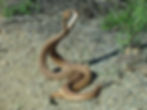Neotropical rattlesnake reproduction and the precarious risks of mating
- Michael Spain
- Apr 15, 2021
- 3 min read
Snake reproduction is understudied and many observations of reproduction happens when researchers come across snakes copulating in the wild or are documented by zoos and private keepers. Recently, a group of researchers took a closer look at copulation of neotropical rattlesnakes (Crotalus durissus) mating in the wild (Almeida-santos et al. 2021).
Snakes are particularly vulnerable to predators when mating due to the structure and function of their sexual organs. The sexual organ of male snakes are called a hemipenis, which is a forked organ that has variable shape and structure among species. Much like many other species of snake, neotropical rattlesnakes’ hemipenes have large and small spines at the base. The spines on the hemipenis function to “lock” male and female snakes together during reproduction and it can be hard to pull mating snakes apart without injury to one or both parties (Porto et al. 2013).

4929. Combat Dancing Rattlesnakes" by Ensie & Matthias is licensed under CC BY-NC-SA 2.0

Male rattlesnakes also engage in combat with each other in the wild, often this combat dance is mistaken for mating rattlesnakes. During mating season and even other times of the year, male rattlesnakes will toss and turn with each other – both snakes competing to topple the other snake and wear them out. The ritual combat dance may have several reasons, including resource competition and reproductive dominance. Ritual combat expends a lot of precious energy from these rattlesnakes and breaking a fight up can be a challenge!
In 2017, ecstatic researchers saw two neotropical rattlesnakes mating beneath the leaf litter in an overgrown area by a pasture. Knowing that mating behavior of Crotalus durissus in the wild had never been documented, they were all excited at the opportunity to document this observation. As you might imagine, when paparazzi researchers stumbled on the two snakes, the female was startled and rushed off into the bush. To the dismay of the male rattlesnake, he was dragged by his hemipenis through the brush for several minutes.
Despite being flushed from the area, once the snakes settled, they copulated for another 20 minutes before parting ways. Researchers observed blood on the ground between the snakes and the male rattlesnake decided to take a breather for another 20 minutes after the incident. After likely combating other male rattlesnakes during the breeding season, traveling to find a female, and the incident of being dragged by his hemipenis, the male was rightfully tired.
This observation was a great discovery to gain more insight into the reproductive biology of rattlesnakes in the wild. Many more questions are left to be answered and we hope to see more information in the future.
Although researchers recently reclassified many subspecies of Crotalus durissus into one species, there are many distinct populations that are unique and there is much to learn about their biology. The Rattlesnake Conservancy recently provided a grant to researchers studying Crotalus durissus (previously Crotalus durissus cascavella) in the Caatinga ecoregion of Brazil and we hope to gain more insight into their biology in the coming years!
Almeida-Santos, S.M., Santos, T., and L. Miguel Lobo. 2021. Mating in free-ranging Neotropical rattlesnakes, Crotalus durissus: Is it risky for males? Herpetology Notes, 14: 225-227.
Porto M., de Oliveira M.A., Pissinatti L., Rodrigues R.L., Rojas-Moscoso J.A., and Cogo J.C. 2013. The Evolutionary Implications of Hemipenial Morphology of Rattlesnake Crotalus durissus terrificus (Laurent, 1768) (Serpentes: Viperidae: Crotalinae). PLoS ONE 8(6): e66903.
.png)